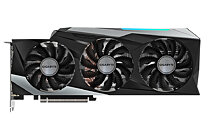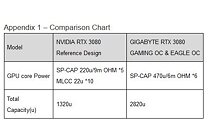Tuesday, September 29th 2020

GIGABYTE Offers Statement Regarding the SP-CAP and MLCC Capacitor on GeForce RTX 3080 Graphics Cards
In response to the recent reports speculating that the use of POSCAP capacitors on the GeForce RTX 3080 graphics cards could lead to stability issues and crashes, GIGABYTE would like to clarify the issue with the following statement. It is false that POSCAP capacitors independently could cause a hardware crash. Whether a graphics card is stable or not requires a comprehensive evaluation of the overall circuit and power delivery design, not just the difference in capacitor types. POSCAPs and MLCCs have different characteristics and uses, thus it is not true to assert that one capacitor type is better than the other.
The GIGABYTE GeForce RTX 30 graphics cards are designed in accordance with NVIDIA specifications, and have passed all required testing, thus the product quality is guaranteed. GIGABYTE GeForce RTX 3080 GAMING OC and EAGLE OC series graphics cards use high-quality, low-ESR 470uF SP-CAP capacitors, which meet the specifications set by NVIDIA and provide a total capacity of 2820u in terms of GPU core power, higher than the industry's average. The cost of SP-CAP capacitors is not lower than that of MLCCs. GIGABYTE values product integrity highly and definitely does not reduce costs by using cheap materials.NVIDIA has released a driver (version 456.55) on September 29, 2020 that improves stability. Users are advised to update to the latest driver for optimized performance. For users who have any concern, please contact our local service centers or representatives.
GIGABYTE has been constantly improving and optimizing product quality, especially in terms of thermal designs, to provide the best gaming experience to the consumers for decades. For the latest AORUS GeForce RTX 30 graphics card series, we have also paid extra attention to the cooling performance and introduced industry-leading solutions such as MAX-Covered Cooling to ensure that the operation of each component is stable.
The GIGABYTE GeForce RTX 30 graphics cards are designed in accordance with NVIDIA specifications, and have passed all required testing, thus the product quality is guaranteed. GIGABYTE GeForce RTX 3080 GAMING OC and EAGLE OC series graphics cards use high-quality, low-ESR 470uF SP-CAP capacitors, which meet the specifications set by NVIDIA and provide a total capacity of 2820u in terms of GPU core power, higher than the industry's average. The cost of SP-CAP capacitors is not lower than that of MLCCs. GIGABYTE values product integrity highly and definitely does not reduce costs by using cheap materials.NVIDIA has released a driver (version 456.55) on September 29, 2020 that improves stability. Users are advised to update to the latest driver for optimized performance. For users who have any concern, please contact our local service centers or representatives.
GIGABYTE has been constantly improving and optimizing product quality, especially in terms of thermal designs, to provide the best gaming experience to the consumers for decades. For the latest AORUS GeForce RTX 30 graphics card series, we have also paid extra attention to the cooling performance and introduced industry-leading solutions such as MAX-Covered Cooling to ensure that the operation of each component is stable.


20 Comments on GIGABYTE Offers Statement Regarding the SP-CAP and MLCC Capacitor on GeForce RTX 3080 Graphics Cards
Honestly I don't care where the capacitors are made or what type they are as long as they are issue free. I have grown rather fond of gigabyte products. So I will probably keep buying their stuff as long as they don't have serious issues or have alternatives from other manufacturers that gives me more for my money.
From now on, people will start to use SP-CAP/POSCAP interchangably and completely unaware of the tens and thousand of different caps out there.
And what's the impedance/frequency curve like :D
> The cost of SP-CAP capacitors is not lower than that of MLCCs.
Yeah but there's 8(?) MLCCs in an array where you would put a SP-CAP? And then the production time costs on top of that?
nice try guys
Also, this statement is as clear as mud and doesn't really say if there's an issue or not.
Edit: the Chinese version has the exact same sloppiness. Disgraceful AF man
technews.tw/2020/09/30/nvidia-rtx-3080-poscap/
Capacity without frequency/voltage has no meaning. They should have refrained of posting that rubbish table. One does simply does do ONLY electrolytic capacitor without decoupling with ceramics for high frequencies, because they can't do it by design, no matter how good are they. There must be Ceramics as close as possible to IC pin and connected to a properly designed low impedance ground plane to short the HF.
Basically all this fuss is around nothing... it is just a retarded PCB/VRM design. You can blame anything in there... caps are just like a plaster to a corpse now. Why there is such an RF creeping in should be fixed in the first place. There are techniques to cancel it it with smart PCB design, there for the may be cases when everything just works without additional components. This ain't the case.
Bravo for the show in these late days. Any card owners, use your rights and return your cards, wait for new more mature PCB revisions. Driver fix to mitigate switching noise, thus the RF creep is a workaround. It is a step back.
Many AIB makers are just scared of the useless dud stock they have made now. They can only blame themselves. Those who made a delay and braced the issues, respect to them.
i think it does make a difference, but only on factory-OCed cards therefore it think the whole issue is mostly drama...
Undoubtedly the problem was the aggressive brief boost to 2070MHz+ that made the crashes, as he outlines in the video. The driver was supposed to fix this, and it seems it has for a lot of people.
Said as owner of GTX 670 Windforce 3x working to this day BTW.
The new driver is effectivly a minimal downclock to bring those cards under the threshold where they would crash. So problem solved
Finally some one which agrees with my own theory of conspiracy :D
MSI when you will be ready to point out issues at GPU design, I will offer you a warm hag.
But this will not happen, because its best to keep NVIDIA in the list of your friends at any cost.
It's a shame that it is 40 mins long... ZZzzzzzzzzzzzzzzzzzzzzzzzzzzzz. Why can't he be like Fornite youtubers and post like 10-12 min vids? Him and Techjesus... vids are WAY too long.